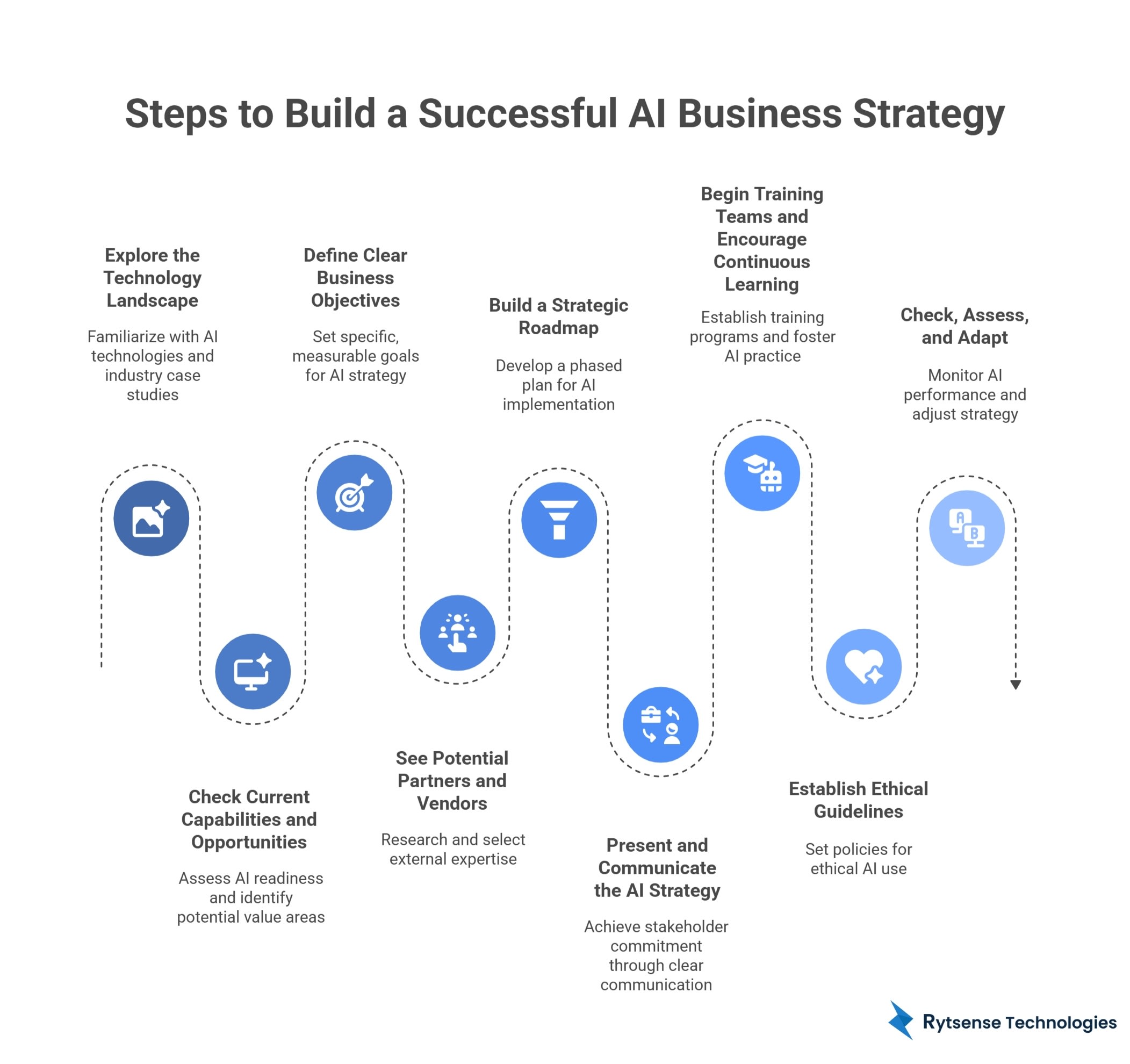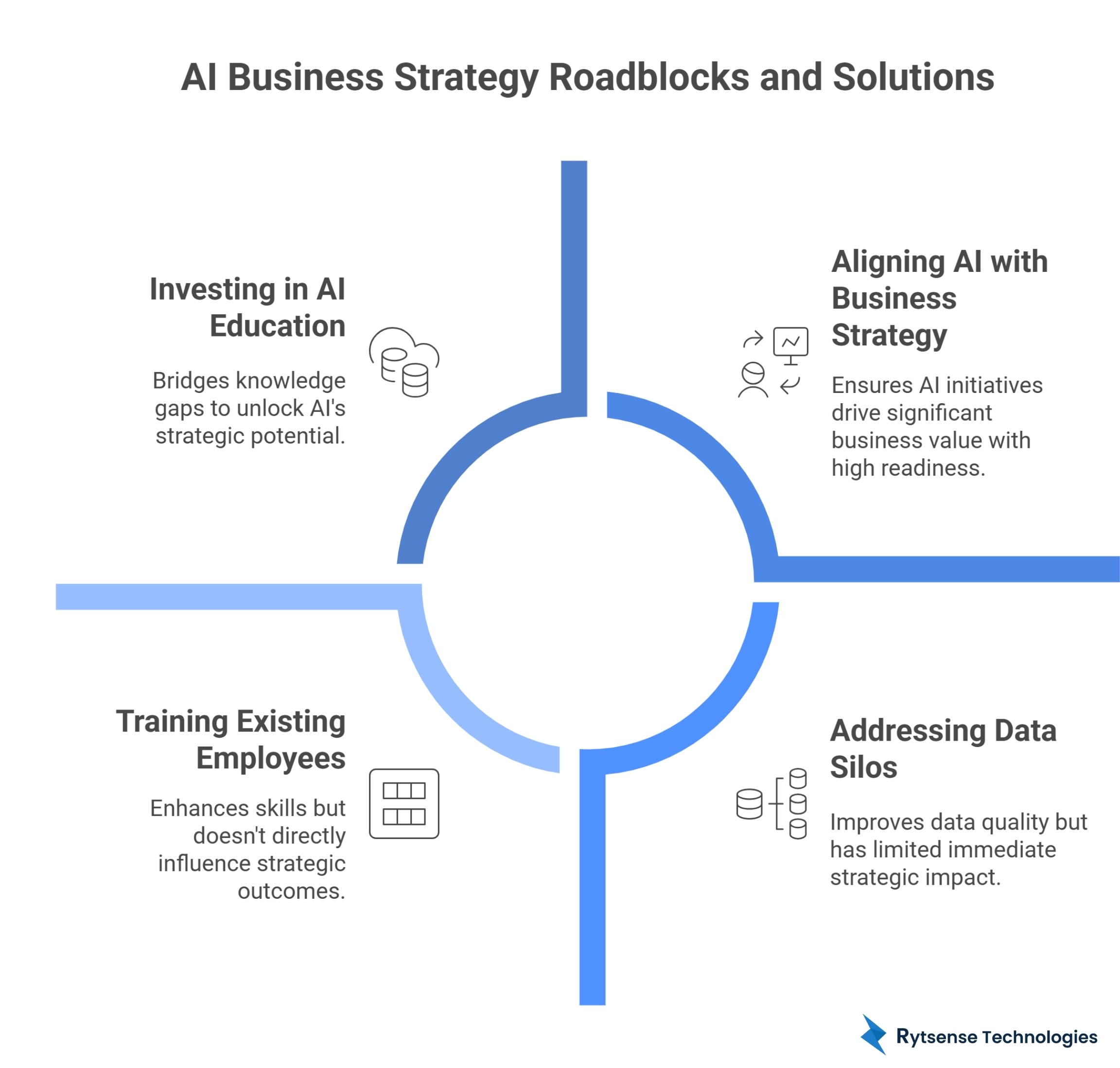-
Key Takeaways
- A successful AI business strategy aligns artificial intelligence initiatives directly with core business objectives to deliver measurable value and competitive advantage. Partnering with a trusted AI ML development company can help streamline this alignment.
- Start with pilot projects that demonstrate quick wins before scaling to larger AI implementations, building organizational confidence and capabilities progressively.
- Address common roadblocks early, including data quality issues, talent scarcity, and knowledge gaps, through training programs and strategic partnerships with AI vendors.
- Establish clear ethical guidelines and governance frameworks to ensure responsible AI use, protect brand reputation, and build stakeholder trust.
- Continuously monitor AI performance against business metrics and adapt your strategy quarterly as technology evolves and market conditions change.
How to Build a Successful AI Business Strategy
Key Components of an AI Business Strategy
An effective AI business strategy provides a structured framework for leveraging artificial intelligence across core business activities to drive growth and competitive advantage. According to recent studies, 72% of businesses have adopted AI in at least one business function, yet only 21% have realized significant value from their AI investments. To close this gap, organizations must focus on:
- Clear Objectives: Define measurable goals that AI can support, from operational efficiency to customer engagement.
- Technology Assessment: Evaluate AI tools, platforms, and frameworks that align with your business needs.
- Implementation Partners: Collaborate with trusted AI development service providers to accelerate adoption and reduce risk.
- Pilot Projects: Start small with targeted AI initiatives before scaling across the organization.
- Team Training: Upskill employees to work effectively alongside AI systems.
- Ethical AI Practices: Establish governance, compliance, and ethical standards for responsible AI use.
- Continuous Evaluation: Monitor AI performance, learn from results, and refine your strategy over time.
By integrating these components into your AI business strategy, organizations can move beyond experimentation and unlock measurable value from AI initiatives, gaining a competitive edge in today’s data-driven market.
What Is an AI Business Strategy?
An AI business strategy is a comprehensive plan for your business for how your organization will use artificial intelligence to accomplish business goals. An AI business strategy defines where AI can create value, identifies the resources needed, and determines how you will execute and implement the strategy. Developing a business strategy is distinct from a digital transformation strategy in that it is focused specifically on using AI technologies, such as machine learning, natural language processing, computer vision, and similar advanced technologies, to address business problems and gain a competitive advantage.
Breakthroughs in AI Models, Agents, Hardware, and Products
Recent developments have transitioned AI from a trial technology to enterprise-ready technology solutions. Large language models now understand context and produce world-class content. AI agents can now independently tackle complex tasks without humans needing to step in and intervene. AI chips may now process 10x faster, while being cheaper to buy and operate. These developments enable organizations to leverage AI at scale across operations, customer service, and product development.
Benefits of AI Business Strategy
An effective AI business strategy provides tangible benefits:
- Efficiency: AI automates routine tasks, easing previously long transactions by 40–60%, allowing your team to reallocate time to higher-value strategic work.
- Improved decision-making: Enables assembling, analyzing, and acting upon data-driven insights without the risk of bias that slows decision-making. Predictive analytics allows you to act with speed, accuracy, and confidence.
- Cost savings: Automating and optimizing operational processes will save you as much as 20–30% in labor costs across supply chain, customer service, and administrative functions.
- Revenue increases: AI offers the opportunity to personalize the customer experience while simultaneously releasing new AI-enabled products that yield revenue increases of between 10–15%.
- Competitiveness: Companies that embrace AI early couple the above benefits with a firm market position, providing a competitive advantage that is difficult for competitors to duplicate.
Transform your business with custom AI strategy development.
Steps to Build a Successful AI Business Strategy

Explore the Technology Landscape
- Familiarize yourself with existing AI technologies. Research generative AI resources, machine learning platforms, natural language processing tools, and computer vision systems.
- Find case studies from your particular industry.
- Attend conferences and webinars.
- The Investigation phase lays the groundwork to help you understand relevant certifications and resources that match your business needs.
Check Current Capabilities and Opportunities
Be honest with yourself and the company when assessing your AI readiness. Analyze your current data architecture, technical talent, technology architecture, and available budget. Identify the current pain points that AI could potentially add immediate value. Look for operational processes to evaluate where there are repeatable patterns, high volume, or data-informed decision-making. When you have completed this assessment, you will see gaps to address and which priorities you can address and leverage.
Define Clear Business Objectives
The initial step is to create clear, measurable objectives for your generative AI business strategy. Instead of generic objectives, such as “better customer service,” consider more specific measurable goals, such as, “reduce time taken today to respond to customers’ inquiries by 50% within 12 months” or “increase accuracy of sales forecasts to 85%.” Have clear goals, it will allow you to measure progress and ROI. Make sure AI objectives align with the broader business strategy helps ensure buy-in from the organization as well.
See Potential Partners and Vendors
Most successful AI projects require some external expertise. Conduct research on technology vendors, consultancy firms, and implementation partners. When selecting partners, evaluate their industry-specific experience, technical capabilities, and client success stories. Keep in mind that there are significant differences between established large vendors and innovative start-ups. Your goal should be to build relationships with a few select partners to mitigate risk and gain access to diverse perspectives.
Build a Strategic Roadmap
Lay out a phased plan for implementing your AI strategy. Start with pilot programs to demonstrate quick wins and build organizational confidence, then scale larger initiatives as capabilities grow. Your roadmap could include the following:
| Phase | Timeline | Focus Areas | Success Metrics |
|---|---|---|---|
| 1 | 0-6 months | Quick wins, pilot projects | ROI from pilots, team capability |
| 2 | 6-18 months | Scale proven solutions | Cost savings, efficiency gains |
| 3 | 18-36 months | Advanced AI, innovation | Revenue growth, market position |
Begin Training Teams and Encourage Continuous Learning
AI succeeds because of people, not just technology. Establish a training program that covers foundational AI concepts, the practical use of implemented tools, and the ethical responsibilities involved. Encourage employees to practice using AI tools in their daily work, and create communities of practice where team members can share insights and experiences. Review training budgets regularly, as ongoing educational resources are essential to keep pace with rapidly evolving AI capabilities.
Establish Ethical Guidelines
Establish clear policies to govern AI use. Guidelines should address data privacy, algorithmic bias, transparency, and accountability. Set up an approval process for high-risk AI applications and create review boards responsible for ensuring ethical AI use. Whenever possible, document the rationale behind AI-powered decisions, especially when they affect customers or employees.
Check, Assess, and Adapt
Justify the selection of metrics used to measure AI performance against business objectives. In addition to tracking technical metrics like model accuracy, also monitor business outcome metrics such as incremental revenue, customer retention, and satisfaction scores. Conduct quarterly reviews to assess the effectiveness of work processes relative to strategic goals and evolving business conditions. AI technology is rapidly evolving, requiring frequent adaptation to maintain alignment with objectives.
Common Roadblocks in AI Business Strategy

Insufficient Data
Many AI models require large amounts of quality data. Many organizations learn too late that the data can be incomplete, separated into silos between systems, and poorly structured. You should address that by employing data governance, creating data lakes, and cleaning current datasets before deploying AI at scale.
Less Knowledge and Expertise About AI
Leadership teams often lack understanding of the capabilities and limitations of AI. This gap can lead to unrealistic expectations or missed opportunities. Address this by investing in executive education, such as workshops on AI strategy and implementation, and by adding AI experts to key strategic roles within the organization.
Not arranged with Overall Business Strategy
Organizations risk wasting resources on AI initiatives that are disconnected from business priorities and fail to deliver measurable value. To avoid this, ensure every AI initiative has an executive-level sponsor from the funding department and aligns with strategic business objectives. Clearly define KPIs to measure outcomes such as revenue growth, cost savings, or improvements in customer experience.
Scarcity of Skilled Talent
The demand for AI talent is highly competitive, and organizations often struggle to recruit data scientists, machine learning engineers, and other AI professionals. To address this challenge, common strategies include training existing employees, partnering with universities, leveraging managed AI services, and creating compelling career paths to attract and retain technical talent.
Unlock the full potential of AI in your business.
AI’s Role in Transforming Business Strategy
Emerging Roles for AI in Strategy Development
AI is increasingly involved in strategy development. Scenario planning tools can assess thousands of market variables to surface trends and opportunities, competitive intelligence platforms track competitor movements in real-time, and predictive models identify potential industry disruptions. Today, these AI strategy tools enable a faster, more data-driven approach to strategic planning, helping organizations make informed decisions and respond proactively to market changes.
Agentic AI: From Pilots to Enterprise Impact
Agentic AI represents the next evolution of autonomous systems that can plan, execute, and learn from complex tasks. Currently, enterprises are exploring opportunities to use Agentic AI for real-time autonomous decisions in areas such as supply chain optimization, dynamic pricing, and customer experience optimization. In the future, as these systems become more practical, they will take on a wider range of strategic functions, still requiring human oversight for governance and direction rather than direct execution.
Key Considerations for Strategy Leaders
Strategy leaders are responsible for evaluating both the opportunities presented by AI and the organization’s readiness. Begin by identifying AI use cases with clearly defined objectives, measurable KPIs, and potential ROI. Form cross-functional teams that combine business, data science, and engineering expertise. Establish feedback loops to monitor alignment between strategy and execution. Remain flexible, adjusting timelines and plans as the company’s ideas and capabilities evolve in response to AI initiatives.
Also Read:
AI ML development servicesMoving from Strategy to Execution
Essentials of AI Strategy for Businesses
Five factors are essential for the successful execution of an AI strategy: leadership buy-in, sufficient budget, adequate talent and resources, data and reporting infrastructure to leverage AI, and effective change management. Without these factors, even well-designed strategies may fail. Ensure these elements are established before undertaking large AI projects.
Turning AI Strategy into Actionable Plans
Break down strategic objectives into discrete projects with clear ownership, defined timeframes, and measurable success benchmarks. Use an iterative process based on agile methodologies to facilitate rapid delivery. Start with small-scale pilots, then scale initiatives after demonstrating measurable value. Form cross-functional project teams that integrate business and technology stakeholders, including product managers, data scientists, and engineers. Establish regular communication touchpoints to monitor progress and quickly identify blockers.
Continuous Realignment and Iteration
AI technologies and business conditions are highly dynamic. Schedule a quarterly assessment of your AI strategy to evaluate which initiatives are meeting KPIs, which need improvement, and where new opportunities may exist. Continuously monitor emerging AI breakthroughs relevant to your field. Be open to adjusting strategic directions to capitalize on greater opportunities or address aspects of the initial plan that are not delivering results.
Conclusion
Developing an AI business strategy designed for growth requires solid planning, cross-organisational collaboration, and a commitment to continuous flexibility and assessment. By following key steps, from the initial evaluation of technology and assessment of capabilities to implementation, iteration, and monitoring, organizations can capture AI’s transformative potential. The critical elements include defining focused business objectives, building necessary capabilities such as talent and data infrastructure, and planning for adaptability in the rapidly evolving AI landscape. Organizations that develop a holistic, sophisticated AI strategy today will be well-positioned to become industry leaders in the years to come.
Build your AI business strategy with Rytsense Technologies — your trusted partner in AI development and integration.
Meet the Author

Karthikeyan
Connect on LinkedInCo-Founder, Rytsense Technologies
Karthik is the Co-Founder of Rytsense Technologies, where he leads cutting-edge projects at the intersection of Data Science and Generative AI. With nearly a decade of hands-on experience in data-driven innovation, he has helped businesses unlock value from complex data through advanced analytics, machine learning, and AI-powered solutions. Currently, his focus is on building next-generation Generative AI applications that are reshaping the way enterprises operate and scale. When not architecting AI systems, Karthik explores the evolving future of technology, where creativity meets intelligence.